Recent News
- Towards power quality improvement July 18, 2022
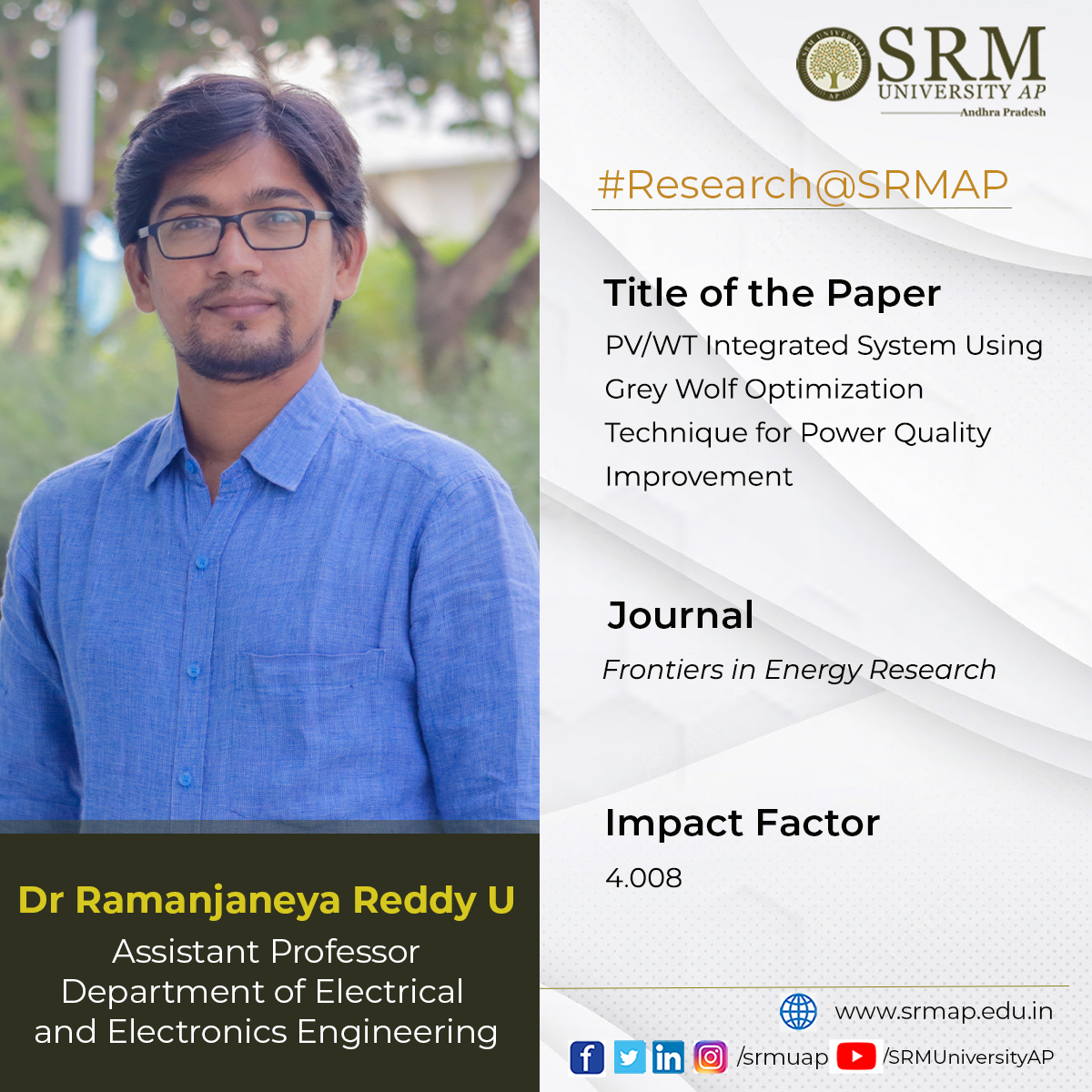 In future, there is a lot of scope for enhancing the power quality using various controllers whose gains are obtained using different optimisation techniques to mitigate several issues. Assistant Professor Dr Ramanjaneya Reddy, Department of Electrical and Electronics Engineering, envisions this tomorrow through his new research paper PV/WT Integrated System Using Grey Wolf Optimization Technique for Power Quality Improvement. The paper is published in the Process, and Energy Systems Engineering section of the Frontiers in Energy Research journal and has an impact factor 4.008. For this research paper, he has collaborated with Assistant Professor Srikanth Goud, Anurag College of Engineering Ghatkesar, Telangana.
In future, there is a lot of scope for enhancing the power quality using various controllers whose gains are obtained using different optimisation techniques to mitigate several issues. Assistant Professor Dr Ramanjaneya Reddy, Department of Electrical and Electronics Engineering, envisions this tomorrow through his new research paper PV/WT Integrated System Using Grey Wolf Optimization Technique for Power Quality Improvement. The paper is published in the Process, and Energy Systems Engineering section of the Frontiers in Energy Research journal and has an impact factor 4.008. For this research paper, he has collaborated with Assistant Professor Srikanth Goud, Anurag College of Engineering Ghatkesar, Telangana.Abstract
This work presents the integration of renewable energy sources such as PV and wind into the grid. Hybrid shunt active power filter (HSHAPF) is optimised with the grey wolf optimisation (GWO) and fractional order proportional integral controller (FOPI) for harmonic reduction under non-linear and unbalanced load conditions. With the use of GWO, the parameters of FOPI are tuned, effectively minimising the harmonics. The proposed model has effectively compensated the total harmonic distortions (THD) when compared with filter, without filter, with passive filter, active power filter with PI controller, and GWO- FOPI-based controller. The performance of the proposed controller is tested under non-linear and unbalanced conditions. The parameters of the FOPI controller are better tuned with the GWO technique. The comparative results reflect the best results of GWO-FOPI based HSHAPF. The suggested controller is built in the MATLAB/Simulink Platform.
Explanation of the research
Power quality (PQ) problems in the distribution system occur when non-linear loads are used. With the development in semiconductor technology, the modelling and usage of power electronic devices are increasing on the end-user side. Because of the usage of power, electronic devices give rise to many problems like a disturbance in reactive power, poor power factor, harmonic distortion, etc. These problems cause severe effects on the distribution system, which results in PQ issues. To mitigate PQ issues, there are many controlling techniques that ensure harmonic free. Initially, passive filter usage was widely considered for harmonic elimination and reactive power compensation. Due to various remarkable disadvantages like constant compensation performance, large size, resonance, etc., the usage became less. To mitigate the reactive power compensation and harmonics, active power filters (APF) became more prominent as the performance characteristics are very effective compared to conventional filters. APF is the device that generally produces an equal quantity of harmonics when compared with the load with a phase shift of 1800. These harmonics are injected into the linear PCC, load current harmonics mitigate, and supply becomes sinusoidal. The active power filters are broadly classified as series APF and shunt APF. The basic structure of shunt APF is illustrated in Figure.1, which mitigates the load current harmonics by inserting equal but opposite harmonic compensating current. Several authors have conducted research on grid integration using RES, active power filters, PQ issues, and various types of controllers designed to mitigate in the hybrid integrated system. In this work, THD reduction under non-linear load, unbalanced load without filter, with passive filter, with active power filter using a PI controller, and the proposed controller is introduced, which results in the best reduction of harmonics under various load conditions.
Practical implementation of the research
The proposed system is designed using both passive and active filters. The designed model improves the filer’s compensation characteristics, reducing the disadvantages of both active and passive filters. In this proposed work, HSHAPF is implemented with the combination of LC passive filter and voltage source PWM converter illustrated in Figure. 2, which illustrates the RES and HSHAPF connected to the grid. This design is tested at various loads, such as non-linear loads and unbalanced loads. Both filters’ characteristics are designed to provide the best performance under different operating conditions. To filter out the harmonics, the designed structure is modelled with storage systems using the battery, DC link and switches with antiparallel diodes. At PCC compensating current is injected using a voltage source converter to mitigate the harmonics. To overcome the power rating required for the PWM converter, the system is modelled using both active as well as passive filters to mitigate the harmonics. Here power MOSFETs are used in designing the PWM converters, which is cost-effective. To eliminate the harmonic at the PCC, equal and opposite magnitude harmonic current has to be injected, which also improves the PQ in the distribution system.
- Nature-inspired Seagull Optimisation Approach algorithm July 12, 2022
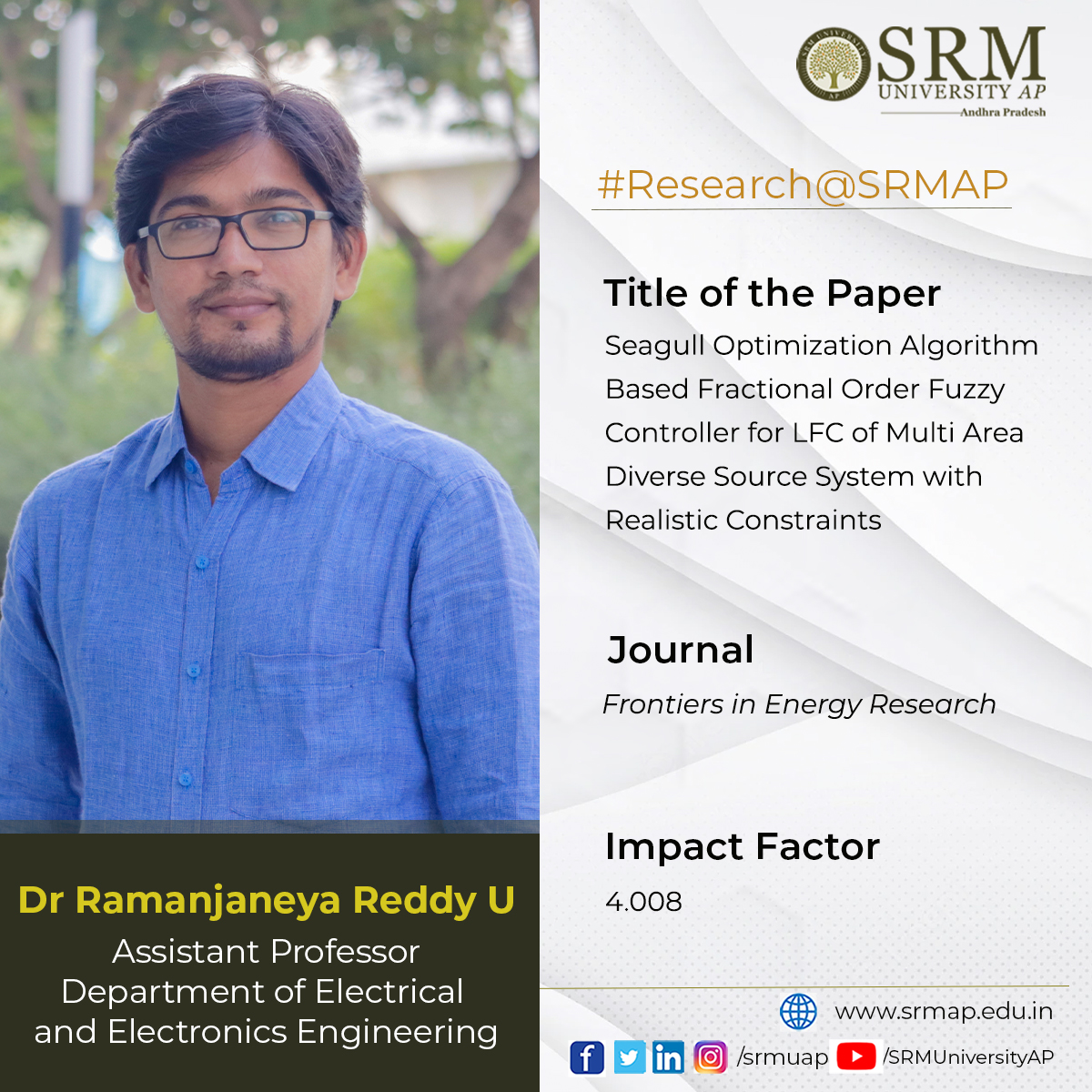 In modern days, the most potent ancillary service is the LFC, especially for controlling and operating interconnected power system networks. The electrical system is becoming more complex due to the integration of several diverse sources generating units to meet the variable load demand. Research in the Department of Electrical and Electronics Engineering is currently working on this area. Assistant Professor Dr Ramanjaneya Reddy recently published a paper titled Seagull Optimization Algorithm Based Fractional Order Fuzzy Controller for LFC of Multi Area Diverse Source System with Realistic Constraints in the Frontiers in Energy Research journal. It is published in the Smart Grids section of the journal with an impact factor of 4.008.
In modern days, the most potent ancillary service is the LFC, especially for controlling and operating interconnected power system networks. The electrical system is becoming more complex due to the integration of several diverse sources generating units to meet the variable load demand. Research in the Department of Electrical and Electronics Engineering is currently working on this area. Assistant Professor Dr Ramanjaneya Reddy recently published a paper titled Seagull Optimization Algorithm Based Fractional Order Fuzzy Controller for LFC of Multi Area Diverse Source System with Realistic Constraints in the Frontiers in Energy Research journal. It is published in the Smart Grids section of the journal with an impact factor of 4.008.Abstract
This paper initiates the implementation of fractional order (FO) fuzzy (F) PID (FOFPID) controller fine-tuned using a seagull optimisation algorithm (SOA) for the study of load frequency control (LFC). Initially, the SOA tuned FOFPID regulator is implemented to the widely utilized model of dual area reheat-thermal system (DARTS) named as test system-1 in this work for a perturbation of 10% step load (10%SLP) on area-1. Dynamical analysis of the DARTS system reveals the viability of SOA tuned FOFPID control scheme in regulating frequency deviations effectively compared to other control schemes covered in the literature. Later, the presented regulator is implemented in multi-area diverse sources (MADS) system possessing realistic constraints in this paper termed test system-2. The sovereignty of the presented FOFPID controller is once again evidenced with controllers of PID/FOPID/FPID fine-tuned with the SOA approach. Moreover, the effect of considering practical realistic non-linearity constraints such as communication time delays (CTDs) on MADS system performance is visualized, and the necessity of its consideration is demonstrated. Further, AC-DC lines are incorporated with MADS system to enhance the performance under heavy load disturbances and the robustness of the proposed regulatory mechanism is deliberated.
Explanation of the research
The operating point of the generation unit must be altered to keep the real power mismatch (RPM) as minimum as possible. RPM is the exact difference between the amount of real power generated by the generation units and the existing load demand. This RPM is the direct analogy to one of the power full parameters in the interconnected network, frequency. Thus, the minimisation of RPM should be monitored continuously as there will be continuous fluctuations in load demand. This must be done automatically. Otherwise, the real power mismatch may worsen and affect the power system frequency. Frequency regulation must be made with the utmost care; if not, it adversely affects the power system stability. LFC will quickly and automatically accomplish this task.
From the literature on LFC, it is apparent that the optimisation-based controllers significantly handle LFC performance. Hence, applications of new optimisation algorithms for solving realistic power system problems are always welcome. In this regard, this paper implements a new nature-inspired seagull optimisation approach (SOA) algorithm. It is a maiden attempt, especially for power system operation and control of IPS with practical constraints. Until now, the regulators presented by the researchers are tested on linearised and non-linearised power system models without and with integrating renewable energy units. To authenticate the investigative analysis of LFC closer to the nature of the realistic practice, the researchers must adopt the non-linearity constraints with power system models. Constraints of non-linearity like GRC and GDB are considered widely by the researchers and paid less attention to other constraints of CTDs.
In realistic practice, IPS are widely spread and employs numerous sensing and phasor measurement devices. The measured data will be transmitted and received among different devices located at distant places via communication peripherals. Exchange of information won’t be done instantly, and a specific time delay exists. The delay might affect the IPS performance; hence, this paper tried to investigate the predominancy of time delays in coordination with the constraint of GRC. Little work is available on studying LFC with CTDs and is restricted up to the implementation of traditional regulators. Thus, this paper addresses the impact of realistic constraint parameter that is CTDs on IPS performance in coordination with GRC under fuzzy aided FO-based regulator based on the newest optimization algorithm.
Practical implementations of the research
This work considered two different power system networks to assess the FOFPID controller performance. One is DARTS, termed test system-1, and the other is MADS, termed test system-2. DARTS model incorporates thermal units of reheat-type turbines in both areas with equal generation capacities. On the other hand, the MADS system that tests system-2 consists of two areas having Thermal-Hydro-Gas units in area-1, and area-2 comprises Thermal-Hydro-Wind units. The participation factor for each source of generation unit is allocated to achieve smooth load distribution and is considered as 0.6225 for thermal, 0.3 for hydro unit, and a factor of 0.075 for gas/wind unit. The required data to build the DARTS system depicted in Figure 1 and MADS system model depicted in Figure 2 are considered from [13] and [35], respectively. The power system models are designed in the (R2016a) version of MATLAB/SIMULINK.
In the future, there is a lot of scope for assessing the effect of CTDs on LFC performance and the implementation of SOA-based FOFPID for optimising IPS in the restructured environment.
Continue reading → - Enhanced dynamic performance in DC-DC converter-PMDC motor combination June 22, 2022
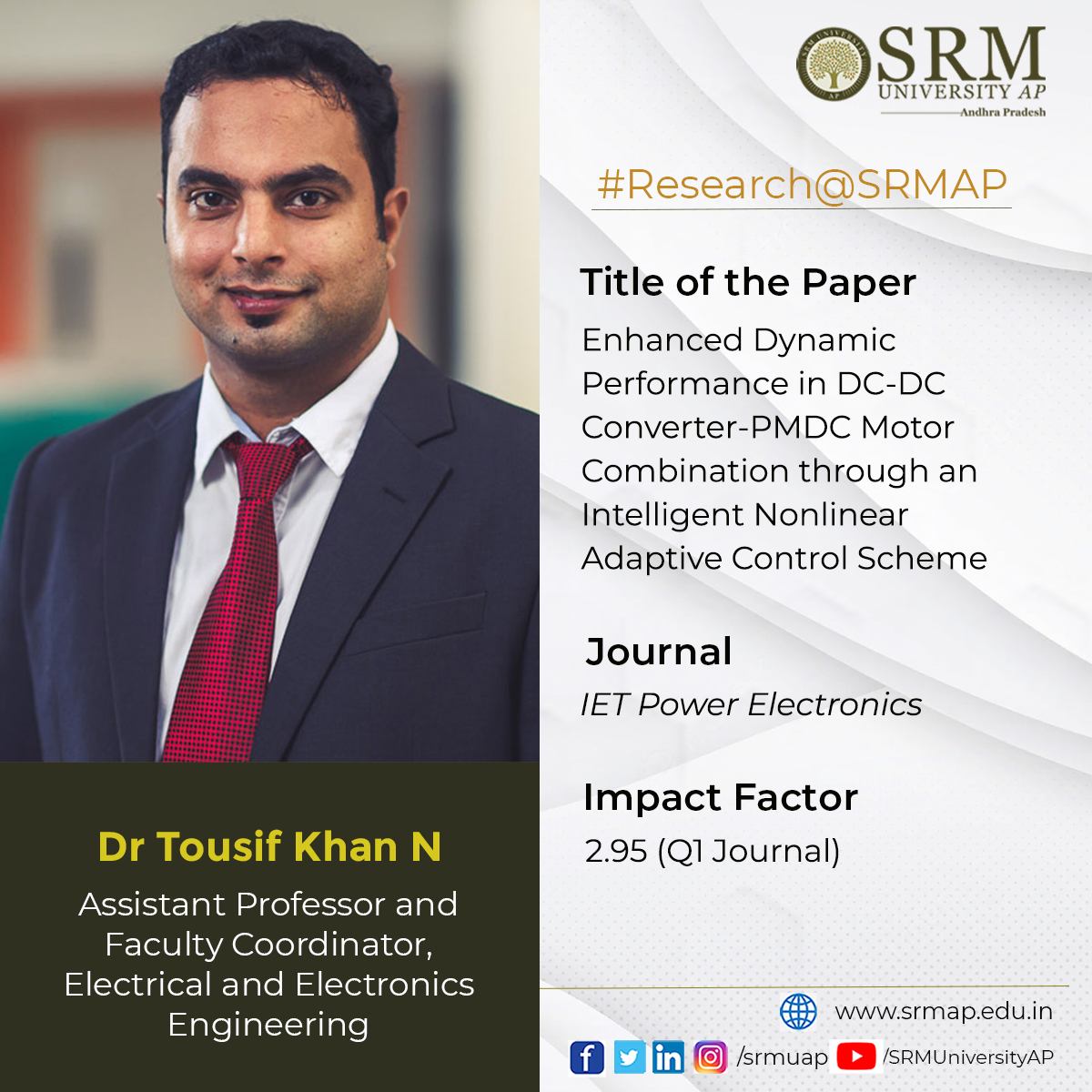 “Enhanced Dynamic Performance in DC-DC Converter-PMDC Motor Combination through an Intelligent Nonlinear Adaptive Control Scheme”, is the latest paper published by Dr Tousif Khan, Assistant Professor of EEE Department at SRM University-AP in the reputed IET Power Electronics (Q1 journal) having an Impact Factor of 2.95.
“Enhanced Dynamic Performance in DC-DC Converter-PMDC Motor Combination through an Intelligent Nonlinear Adaptive Control Scheme”, is the latest paper published by Dr Tousif Khan, Assistant Professor of EEE Department at SRM University-AP in the reputed IET Power Electronics (Q1 journal) having an Impact Factor of 2.95.Abstract
A novel neuro-adaptive control scheme is proposed in the context of angular velocity tracking in DC-DC buck converter-driven permanent magnet DC motor system. The controller builds upon the idea of backstepping control. The proposed method guarantees a rapid recovery of nominal angular velocity tracking under parametric and non-parametric uncertainties. In order to verify the performance of the proposed neuro-adaptive speed controller, extensive experimentation has been conducted in the laboratory under various real-time scenarios. Results are obtained for start-up, time-varying angular velocity tracking and under the influence of highly non-linear unknown load torque. The performance metrics such as peak undershoot/overshoot and settling time are computed to quantify the transient response behaviour. The results clearly substantiate theoretical propositions and demonstrate an enhanced dynamic speed tracking under a wide operating regime, thus confirming the suitability of the proposed method for fast industrial applications.
Continue reading → - Dr Tousif Khan published in Springer Nature June 20, 2022
The Department of Electrical and Electronics Engineering is proud to announce that the estimable book of Springer Nature, ‘Soft Computing: Theories and Applications’ has featured three publications by Dr Tousif Khan, Assistant Professor. His publications are part of the book series, Lecture Notes in Networks and Systems (LNNS), Volume 425. The book stimulates discussions on various emerging trends, innovations, practices, and applications in the field of soft computing, ranging from data mining, prediction analysis, control systems, image processing, health care, medicine, agriculture analysis, supply chain management and cryptanalysis etc.
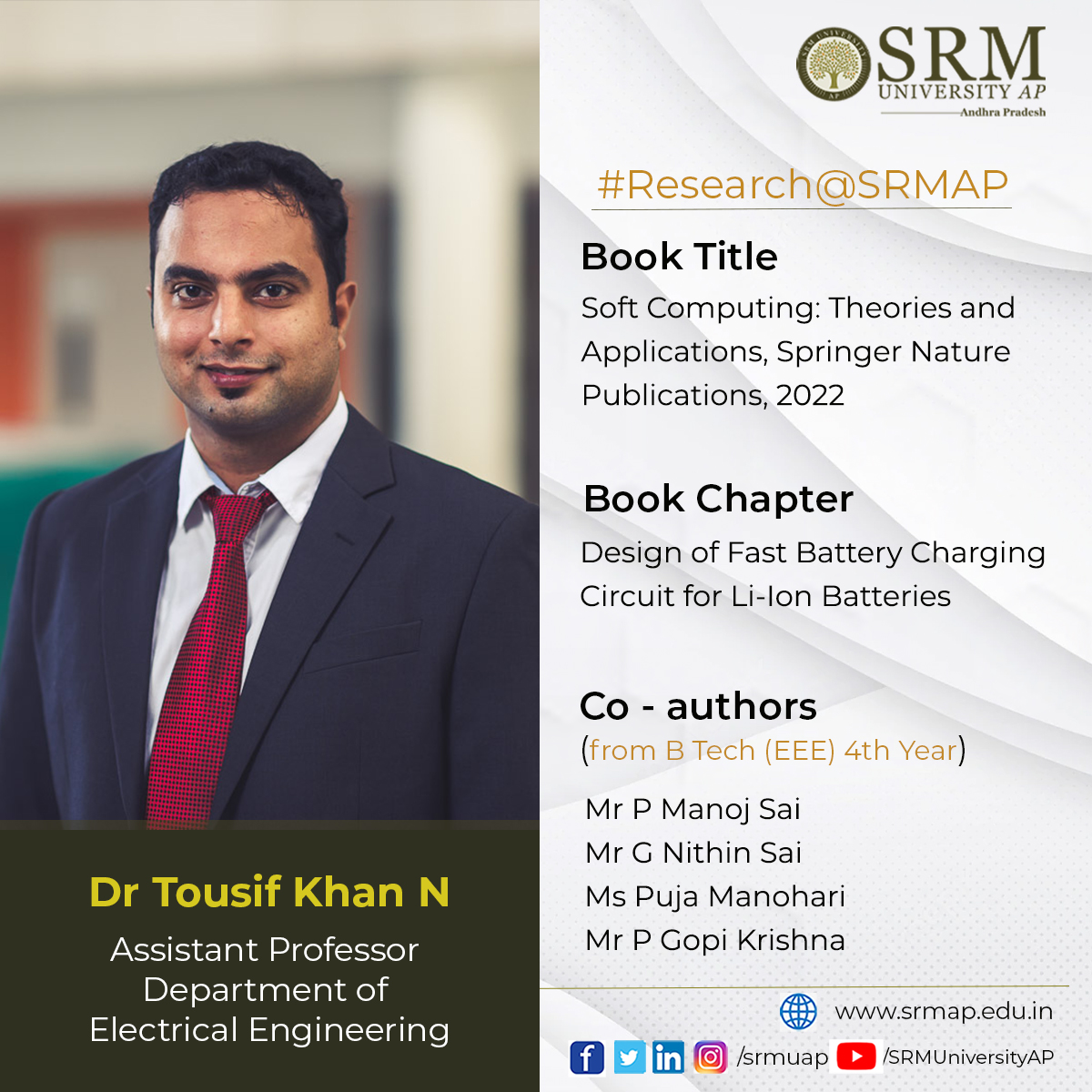 The first chapter titled “Design of Fast Battery Charging Circuit for Li-Ion Batteries” was co-authored by Dr Khan along with the final year EEE students; P Manoj Sai, G Nithin Sai, Puja Manohari, and P Gopi Krishna. In this chapter, a battery charging topology has been designed and developed for the fast charging of Li-ion batteries. The charging circuitry comprises a Proportional-Integral-Derivative (PID) controlled DC-DC buck converter system for reducing the charging time in Li-ion batteries. Battery charging time depends on several factors and the charging current is one of the major criteria. In this work, the buck converter is used to attain a high charging current, besides providing the regulated voltage to the battery. Initially, the AC supply obtained from the mains is converted to DC using an AC-DC rectifier. The rectifier output is further fed to the buck converter to increase the output current of the circuit. The buck converter reduces the output voltage and increases through it.
The first chapter titled “Design of Fast Battery Charging Circuit for Li-Ion Batteries” was co-authored by Dr Khan along with the final year EEE students; P Manoj Sai, G Nithin Sai, Puja Manohari, and P Gopi Krishna. In this chapter, a battery charging topology has been designed and developed for the fast charging of Li-ion batteries. The charging circuitry comprises a Proportional-Integral-Derivative (PID) controlled DC-DC buck converter system for reducing the charging time in Li-ion batteries. Battery charging time depends on several factors and the charging current is one of the major criteria. In this work, the buck converter is used to attain a high charging current, besides providing the regulated voltage to the battery. Initially, the AC supply obtained from the mains is converted to DC using an AC-DC rectifier. The rectifier output is further fed to the buck converter to increase the output current of the circuit. The buck converter reduces the output voltage and increases through it.The circuit parameters are designed by considering the commercially available Lithium-ion battery LIR18650 as the load with a capacity of 2600 mAh and a nominal voltage of 3.7 V. The considered battery requires a standard charging current of 0.5 A, however, the circuit is designed to provide the rapid charge current of 1.3 A as the output by using the buck converter. The converter is operated in continuous conduction mode and helps in charging the battery under constant current mode. To avoid interruption to the charging current when there is a simultaneous discharge of the battery, further improvement in the closed-loop control action is made by employing a PID controller. Extensive simulation work has been conducted using the MATLAB/Simulink tool. The results obtained suggest there is a significant reduction in charging time under different conditions compared to the conventional method of battery charging.
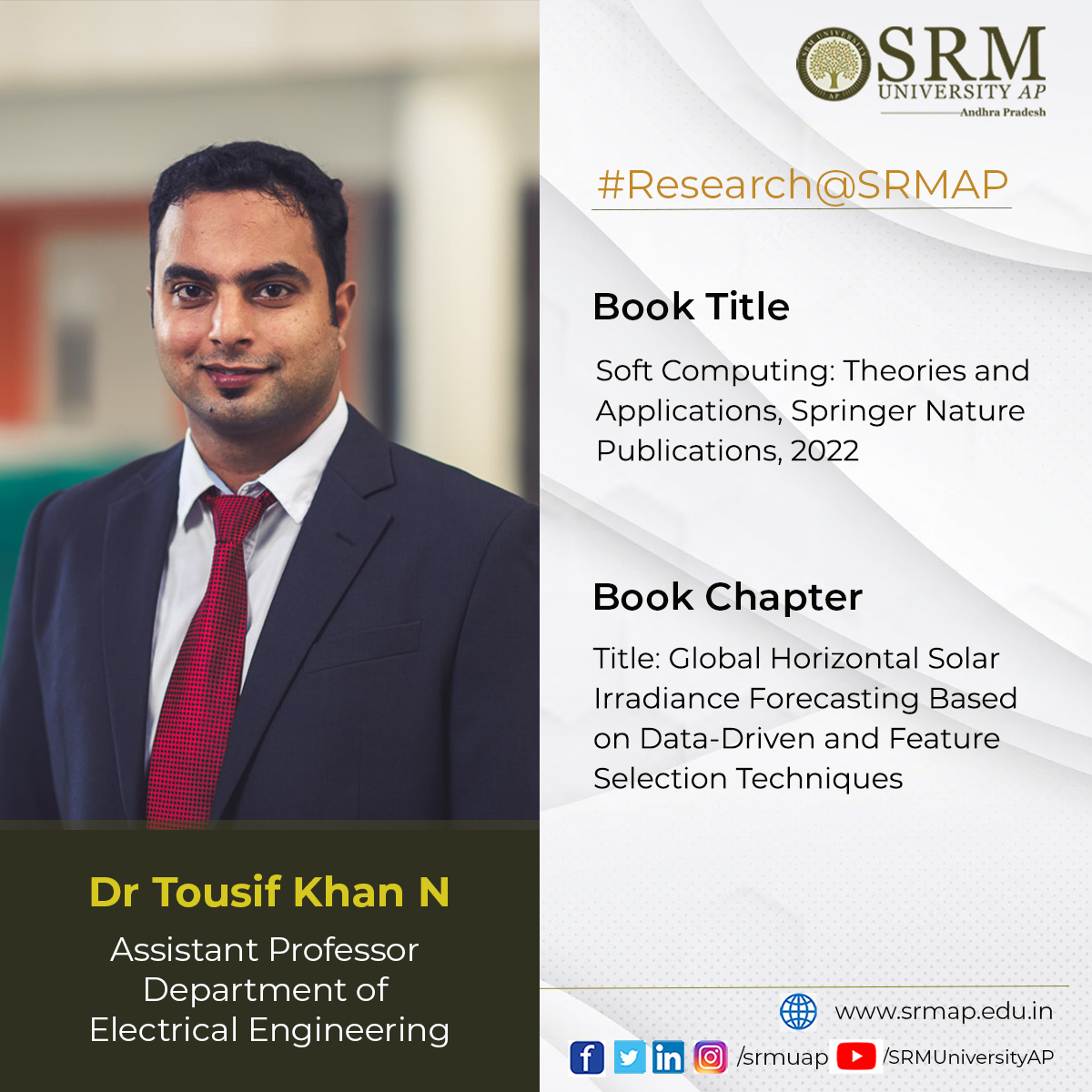 In the chapter, “Global Horizontal Solar Irradiance Forecasting Based on Data-Driven and Feature Selection Techniques”, Dr Khan discusses the need for an accurate solar prediction. It has become an essential part of the renewable energy sector with the rapidly expanding infrastructure of the solar energy system. Over the past decade, various machine learning (ML) algorithms have been used for this purpose. Although the prediction of solar irradiance forecasting has been discussed in many studies, the use of meta-heuristic optimization techniques has not been explored to select features for the forecasting model. This study comprises two meta-heuristic optimization techniques such as simulated annealing (SA) and ant colony optimization (ACO) for feature selection. The results show that feature selection based on meta-heuristics gave better results than models without feature selection.
In the chapter, “Global Horizontal Solar Irradiance Forecasting Based on Data-Driven and Feature Selection Techniques”, Dr Khan discusses the need for an accurate solar prediction. It has become an essential part of the renewable energy sector with the rapidly expanding infrastructure of the solar energy system. Over the past decade, various machine learning (ML) algorithms have been used for this purpose. Although the prediction of solar irradiance forecasting has been discussed in many studies, the use of meta-heuristic optimization techniques has not been explored to select features for the forecasting model. This study comprises two meta-heuristic optimization techniques such as simulated annealing (SA) and ant colony optimization (ACO) for feature selection. The results show that feature selection based on meta-heuristics gave better results than models without feature selection.Amongst the two optimization methods, ACO outperformed SA with some exceptions. For SA, the declining order of performance observed is extreme gradient boosting (XGBoost), random forest (RF), multilayer perceptron (MLP), decision tree (DT) and support vector regression (SVR), while for ACO the declining order observed is XGBoost followed by MLP, RF, DT and SVR. This manuscript indicates the potential capability of meta-heuristic techniques for accurate prediction of global horizontal irradiance (GHI) given a wide array of feature variables.
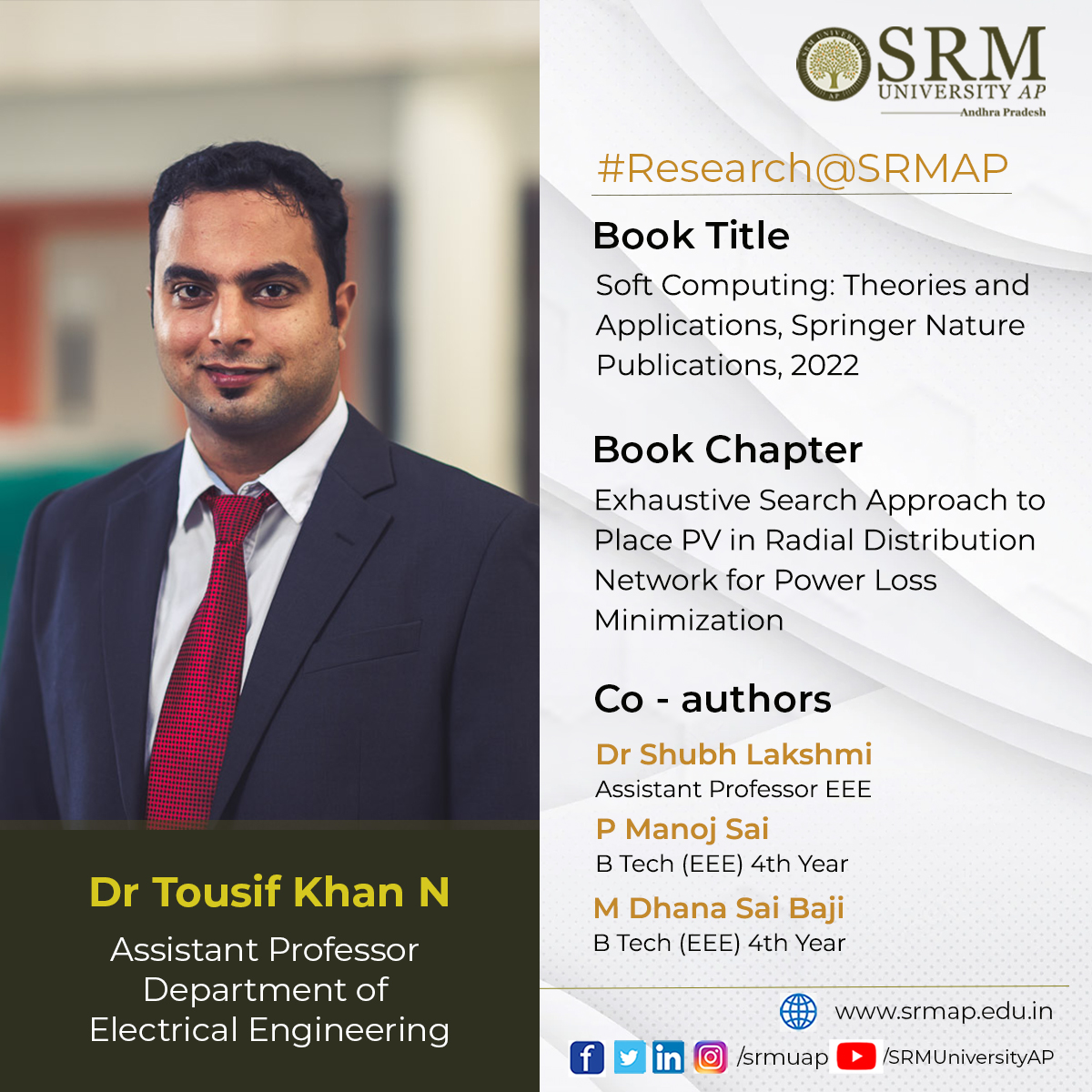 In yet another chapter, “Exhaustive Search Approach to Place PV in Radial Distribution Network for Power Loss Minimization”, co-authored with Dr Shubh Lakshmi, Assistant Professor, and the final year students; P Manoj Sai and M Dhana Sai Baji from the Department of Electrical and Electronics Engineering, an exhaustive search approach to determine the best location and size of PV placement for power loss minimization of radial distribution networks is discussed. In this approach, the network power loss is determined by placing PV in each location, one at a time, and the size of PV in the same location is varied between 10 and 300 kW with an increment of 10 kW.
In yet another chapter, “Exhaustive Search Approach to Place PV in Radial Distribution Network for Power Loss Minimization”, co-authored with Dr Shubh Lakshmi, Assistant Professor, and the final year students; P Manoj Sai and M Dhana Sai Baji from the Department of Electrical and Electronics Engineering, an exhaustive search approach to determine the best location and size of PV placement for power loss minimization of radial distribution networks is discussed. In this approach, the network power loss is determined by placing PV in each location, one at a time, and the size of PV in the same location is varied between 10 and 300 kW with an increment of 10 kW.The combination of location and size of PV which provides the minimum network power loss can be the best location and size of PV for power loss minimization of radial distribution networks. The forward–backward sweep load flow algorithm is used to incorporate the PV model. The 33-bus radial distribution network is used to demonstrate the approach. The simulation results show that the placement of a suitable size of PV in some specific locations significantly reduces the network power loss.
Publishing the latest advancements in Networks and Systems, The LNNS series will serve as an edifying read for all the researchers and scientists across the globe. Volumes published in LNNS give a deep insight into all aspects and subfields of, as well as new challenges in, Networks and Systems. The series encompasses the theory, applications, and perspectives on the state of the art and future developments relevant to systems and networks, decision making, control, complex processes and related areas, as embedded in the fields of interdisciplinary and applied sciences, engineering, computer science, physics, economics, social, and life sciences, as well as the paradigms and methodologies behind them.
- Guest Associate Editor in ‘Frontier in Control Engineering’ journal May 13, 2022
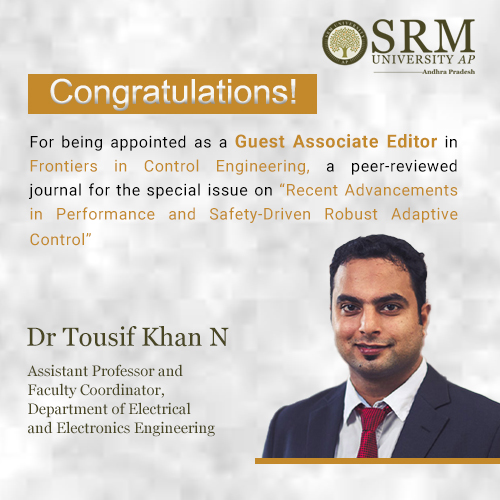 The Department of Electrical and Electronics Engineering is Proud to inform you that Dr Tousif Khan N, Assistant Professor, and Faculty Coordinator, has been appointed as a Guest Associate Editor in Frontiers in Control Engineering, a peer-reviewed journal for the special issue on “Recent Advancements in Performance and Safety-Driven Robust Adaptive Control.”
The Department of Electrical and Electronics Engineering is Proud to inform you that Dr Tousif Khan N, Assistant Professor, and Faculty Coordinator, has been appointed as a Guest Associate Editor in Frontiers in Control Engineering, a peer-reviewed journal for the special issue on “Recent Advancements in Performance and Safety-Driven Robust Adaptive Control.”This Research Topic is intended to give an insight into the latest development regarding the control design and analysis for the nonlinear systems under multiple uncertainties, matched and unmatched disturbances, measurement noises, actuator/sensor faults, and non-smooth nonlinearities. To render a promising control performance under resource-constrained communication networks, state constraints, control constraints, and other related issues are additional design objectives and the focus of this Research Topic.
In conclusion, developing an effective onboard implementable control approach for dynamical systems where safety, performance, uncertainty, and optimality are dealt with concurrently is the main objective of this special issue of the research journal Frontiers in Control Engineering.
Continue reading →

